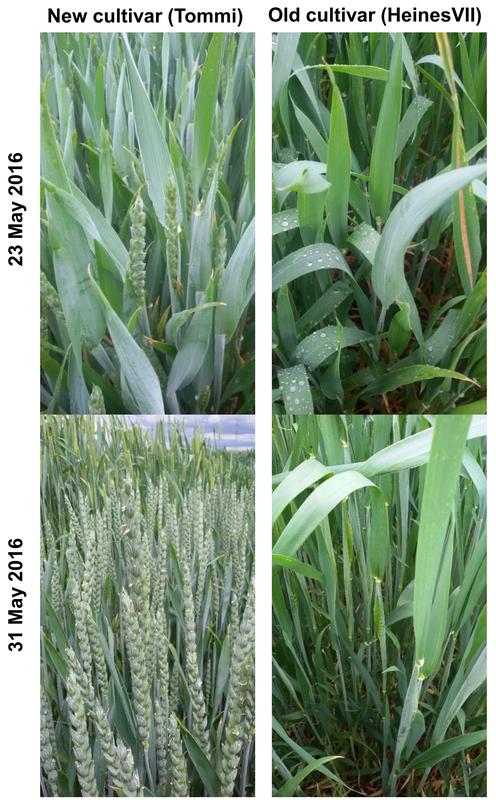Earlier flowering of modern winter wheat cultivars

Field experiment with winter wheat: Comparison of the cultivars “Tommi” (2002) and “Heines VII” (1950) from emergence to flowering. University of Göttingen
Changing crop phenology is considered an important bio-indicator of climate change. Researchers from the University of Göttingen together with colleagues from the University of Bonn investigated how the flowering day of winter wheat has changed within the last 60 years.
They analysed nearly 500.000 phenological observations and found that today winter wheat flowering day is 14 days earlier than 60 years ago. In a field experiment they showed that higher temperatures as well as plant breeding both contribute to the trend towards earlier flowering. The results were published in Scientific Reports.
It has been shown before that the recent warming trend causes an advancement in crop phenology resulting in earlier flowering dates. However, little is known about the contributions of changes in sowing dates and cultivars to long-term trends in crop phenology. The researchers analysed a long-term dataset of phenological observations across western Germany spanning from 1952 to 2013.
In addition, they directly compared the phenology of winter wheat cultivars released between 1950 and 2006 in a two-year field experiment and used the observations to parameterise a crop phenology model which was then applied for the whole study period.
“Changes in the mean temperature and cultivar properties contributed similarly to the trends in the flowering day”, explains Ehsan Eyshi Rezaei, postdoc at the Department of Crop Sciences and lead author of the study. “We found a 14–18% decline in the temperature sum required from emergence to flowering for the modern cultivars of winter wheat compared with the cultivars grown in the 1950s and 1960s.”
In contrary, the effects of changes in the sowing day were negligible. “We conclude that previous climate impact assessments overestimated winter wheat sensitivity to increasing temperature”, says Professor Stefan Siebert, head of the Division of Agronomy. “Future studies and projections on climate change effects should therefore also consider changes in cultivars.”
Original publication: Ehsan Eyshi Rezaei et al.: Climate change effect on wheat phenology depends on cultivar change. Scientific Reports, DOI 10.1038/s41598-018-23101-2, http://www.nature.com/articles/s41598-018-23101-2
Contact:
Prof. Dr. Stefan Siebert and Dr. Ehsan Eyshi Rezaei
Georg-August-Universität Göttingen
Faculty of Agriculture
Department of Crop Sciences – Division of Agronomy
Von-Siebold-Straße 8, 37075 Göttingen
Phone: +49 (0)551 39-24359
Mail: stefan.siebert@uni-goettingen.de and ehsan.eyshi-rezaei@uni-goettingen.de
Website: http://www.uni-goettingen.de/en/40486.html
http://www.uni-goettingen.de/en/3240.html?cid=6097
http://www.nature.com/articles/s41598-018-23101-2
Media Contact
All latest news from the category: Agricultural and Forestry Science
Newest articles

Bringing bio-inspired robots to life
Nebraska researcher Eric Markvicka gets NSF CAREER Award to pursue manufacture of novel materials for soft robotics and stretchable electronics. Engineers are increasingly eager to develop robots that mimic the…

Bella moths use poison to attract mates
Scientists are closer to finding out how. Pyrrolizidine alkaloids are as bitter and toxic as they are hard to pronounce. They’re produced by several different types of plants and are…

AI tool creates ‘synthetic’ images of cells
…for enhanced microscopy analysis. Observing individual cells through microscopes can reveal a range of important cell biological phenomena that frequently play a role in human diseases, but the process of…





















